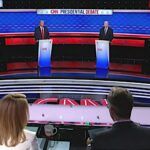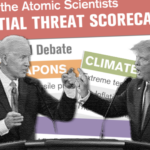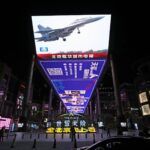Three myths about the Iran sanctions
By Aaron Arnold | April 22, 2015
Speaking from the White House earlier this month, President Obama announced details of a framework agreement between Iran and the P5+1—the United States, Russia, China, France, the United Kingdom, and Germany—that limits Iran’s path to building a nuclear weapon over the next 10 to 15 years. Although negotiators will finalize technical details between now and the June 30 deadline, the parameters provide Iran with sanctions relief in exchange for limits on its uranium enrichment, converting its Arak heavy water reactor, limiting the number and type of centrifuges, and agreeing to intrusive inspections. Should Iran cheat or fail to uphold its end of the bargain, however, the United States and its allies reserve the right to “snap-back” into place tough economic and financial sanctions.
Skeptics of the framework insist that it does not go far enough in preventing Iran’s path to a bomb. Instead, Congressional leaders are pushing for a greater say in approving a final deal. Most recently, Sen. Bob Corker, chairman of the Senate Foreign Relations Committee, tentatively reached bi-partisan support on legislation that would reign in Obama’s ability to provide sanctions relief by requiring the president to submit the final deal to Congress for approval. If Congress decides not to approve the final deal, the alternative is returning to stronger sanctions in hopes of bringing Iran back to the bargaining table.
The view that holding out for a “better deal” by strengthening sanctions does not consider the reality of the current sanctions regime, and is based on bad assumptions and outright myths.
Myth No. 1: International partners will continue to support US-led sanctions. Sanctions on Iran’s energy, shipping, and insurance sectors, along with almost complete financial isolation, have taken a toll. It is easy to imagine that these tough sanctions brought Iran to the negotiating table and, therefore, that the United States should continue to apply sanctions in hopes of gaining a more comprehensive agreement. But only a small percentage of leading scholars believe a strategy involving the threat of increased sanctions would produce a better deal for the United States. One reason is that it is unclear whether or not the United States can maintain an international coalition that supports sanctions against Iran.
In fact, doubling down on sanctions to get a better deal is likely to weaken already waning international support for US-imposed sanctions. President Obama has even expressed doubts that the sanctions regime would remain intact should negotiations fail.
Oil plays a big role here. Tougher sanctions would require deeper cuts in oil imports from Iran, which would likely be a difficult sell for the United States to make. Iran’s top oil consumers have viewed US sanctions as a means to a solution, instead of the solution itself. From the perspective of international partners, failed diplomacy, then, is no cause to accept further reductions in oil imports.
Iranian oil exports currently hover at almost 1.1 million barrels a day, down from 2.5 million in 2011—costing Iran more than $40 billion in lost revenue in the last year alone. But without support from international partners, this revenue loss would be much lower. According to a 2015 Congressional Research Service report, China, India, South Korea, Japan, and Turkey—Iran’s top oil consumers— reduced their cumulative Iranian oil imports by more than half a million barrels per day from 2011 to the start of the Joint Plan of Action in 2013. (Further reductions occurred in other countries but were deemed negligible.) Since the start of the action, some countries have made further reductions. India, for example, is importing only 50,000 barrels a day—down from 348,000 barrels in 2014.
Would international partners continue to support US-led sanctions, if Congressional leaders decide to ramp them up? The answer is not entirely clear. China, for example, has sought to diversify its sources of oil to avoid disruption, pivoting in part to Russia to satisfy its growing energy needs. India, on the other hand, is expected to increase its imports of Iranian oil.
But it may not matter. Globally, low oil prices and oversupply also mean that Iran will face stiff market competition. If sanctions were lifted, it is uncertain whether Iranian oil exports would return to pre-2011 levels.
Myth No. 2: “Snap-back” sanctions will be ineffective against economic momentum in Iran. There has been much debate about the feasibility of “snap-back” sanctions. While the current framework calls for sanctions to spring back into place if Iran does not uphold its end of the bargain, opponents claim that lifting sanctions will provide Iran with enough economic momentum to neutralize the effect of any such sanctions. In a recent statement, Treasury Secretary Jacob Lew characterized sanctions relief as “reversible”.
Some economists believe that Iran could see upwards of 7 to 8 percent growth in its gross domestic product, or GDP, in the years after an agreement as a result of re-joining the global economy. But since 2010, Iran has consistently underperformed compared to its economic peers,primarily due to significant declines in oil production, oil export revenues, and GDP. Despite measured economic growth over the last year, however, without some type of sanctions relief Iran will not be able to fully recover its economy—at least in the short run.
Critics of the feasibility of snap-back sanctions fail to recognize a number of challenges that Iran will have to overcome once the United States, the European Union, and the United Nations begin to lift nuclear-related sanctions.
For one, President Hassan Rouhani’s austerity budget does not take into account a deal with the P5+1, and instead, focuses on continuing to build a strong domestic economy—including a burgeoning manufacturing base, which Iran will want to protect once sanctions are lifted.
Tehran’s second challenge would be re-joining the international banking system, which it has been increasingly frozen out of since 2011 when the United States designated Iran as a “jurisdiction of primary money laundering concern” under Section 311 of the USA PATRIOT Act. This designation requires US banks and other financial institutions to undertake enhanced measures to guard against terrorist financing. Since the only sanctions affected by the framework agreement would be those related to Iran’s nuclear program, many of these PATRIOT Act designations would stay in place. The US designation of Iran’s financial sector explicitly notes the Iranian banks’ role in supporting “terrorism and its pursuit of nuclear and ballistic missile capabilities.” From a risk and compliance perspective, banks would be hesitant to re-engage Iran’s economy. Not wanting to incur stiff penalties, US banks and financial institutions, as well as those subjected to extraterritorial provisions of US sanctions, would be hesitant—if not overly cautious—in re-engaging with Iran. The likely scenario is that some large financial institutions would avoid business with Iran altogether.
In testimony before the House Foreign Affairs Committee, Treasury undersecretary Adam Szubin said that, “Our sanctions are not just words on the books—we vigorously enforce them.” And during negotiations, the Treasury imposed more than $450 million in fines. This comes on the heels of record-setting fines against large banks, such as the almost $9 billion fine against France’s BNP Paribas for sanctions violations. Given such a risky regulatory environment, many banks are opting to shut down banking relationships in countries of concern—a process dubbed “de-risking”—rather than taking a more tailored approach. This will undoubtedly create stumbling blocks for any of Iran’s banks that want to rejoin the global banking system.
Iran will also have to contend with its continued designation by the Financial Action Task Force (FATF)—the global standard-setting body for money laundering and terrorist financing—as a high-risk jurisdiction. FATF continues to call upon its member states to take concerted counter-measures against Iran to protect the international financial system from “substantial money laundering and terrorist financing risks.” FATF’s recommendations focus exclusively on terrorist-related financing concern, and not issues related to Iran’s nuclear ambitions.
Myth No. 3: The United States can continue to control the world financial system. Although not without controversy, the extraterritorial provisions of US-led sanctions provide the backbone to freezing Iran out of the global economy. (That is, the ability to impose harsh penalties on non-US firms for conducting significant business or transactions with Iranian companies.) China’s Bank of Kunlun, for example, was sanctioned by the United States in 2012 for facilitating “significant transactions” and financial services to designated Iranian banks.
The effectiveness of these provisions, however, relies in part on the structure of the international financial system; imposing tougher sanctions for a better bargain rests on the premise that this structure will remain intact. The truth, however, is that major shifts in international banking severely undermine the prospect of maintaining a robust sanctions regime. For example, some of the hardest-hitting rounds of sanctions came in 2012, when the Belgium-based company of SWIFT—the world’s largest financial messaging system—cut off Iran as part of EU sanctions. This move froze Iranian’s access to international markets, devastating its trade and commerce.
This sudden move underscored to other countries the inherent risks in relying on a single access point to international banking, and encouraged them to take a number of moves to mitigate those risks. China, for example, is on schedule to launch an alternative to SWIFT, possibly by the end of 2015. Known as the China International Payment System, it is designed to process cross-border renminbi transactions, in a welcome alternative to the patchwork system of processing Chinese currency payments—making the renminbi a more global currency. The system will provide a legitimate alternative to SWIFT.
Russia recently launched its own alternative to SWIFT for domestic payments, as part of a larger move to get away from Western dominance of the international financial system—specifically citing fears of exclusion from SWIFT stemming from Western sanctions over the escalating crisis in Ukraine.
Reality versus myth. Calls for a “better deal”—relying in part on strengthening sanctions—do not take a realistic view of the current state of the global sanctions regime against Iran. The system is changing, and domestic politics has yet to catch up.
Decades of sanctions have had diffuse global consequences, and emerging trends show that US-led sanctions will not enjoy the same level of legitimacy it has in the past. Given US economic dominance and the appearance of effectiveness, it is understandable how sanctions have become somewhat of a panacea for international diplomacy. The reality, however, is that without better evidence-based policy-making, the United States will find itself unprepared to deal with the broader spectrum of sanctions consequences.
Together, we make the world safer.
The Bulletin elevates expert voices above the noise. But as an independent nonprofit organization, our operations depend on the support of readers like you. Help us continue to deliver quality journalism that holds leaders accountable. Your support of our work at any level is important. In return, we promise our coverage will be understandable, influential, vigilant, solution-oriented, and fair-minded. Together we can make a difference.
Topics: Analysis, Special Topics














